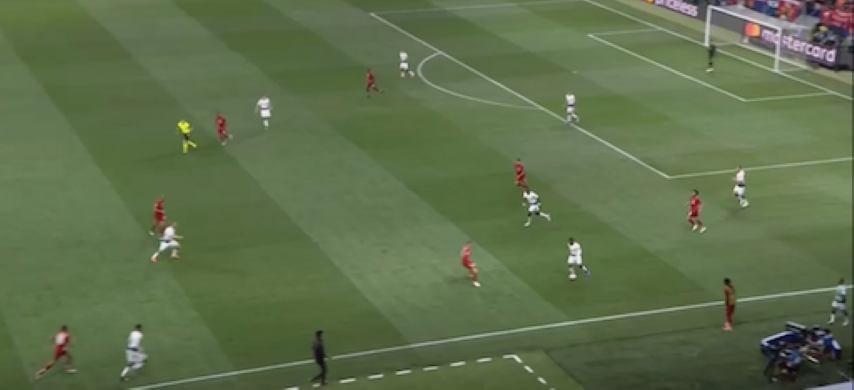WORLD CLASS COACHING
4-3-3 Defending
By Luca Bertolini
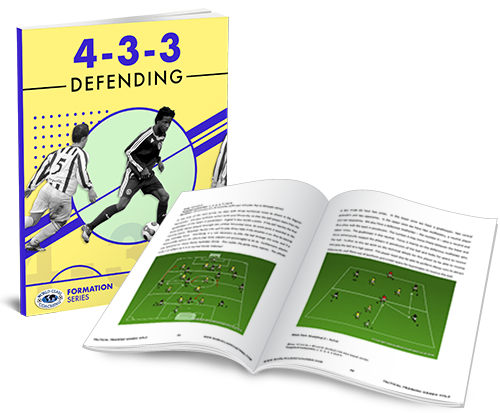
Table of Contents
PART ONE
Introduction
Basic Principles of Play Without the Ball - 1
PART TWO
Basic Principles of Play Without the Ball - 2
Transitions to Defend and Key Defending Principles
PART THREE
Players/Positions Roles and Responsibilities
PART FOUR
4-3-3 Defensive Shapes
Introduction
As already analyzed in the attacking volume, 1-4-3-3 team formation is usually set-up with 3 players lines and with a balanced spread of them over the pitch, shaping ‘triangles’ and creating good conditions for possession and attacking style of play, and also for little group defense phase of the players near the ball, as these triangles help the pressure, coverage and balance actions, once the ball is lost. In this first example, the opposition defender anticipates the CF of the possession team, but the defense triangle is already shaped: CF can press the new ball carrier immediately, the winger retreats back to close the nearest passing lane and the LCM is already placed to provide balance.

In this second example, the CF closes the nearest passing lane toward the center, the winger presses the new ball carrier quickly and the LCM is again already placed to provide balance.

Despite having many points of strength, 1-4-3-3 can be vulnerable, moreover along the flanks, as instance if both fullbacks push up, leaving a 3 man back line without a proper preventive coverage and it can be vulnerable to counter attacks as well, in case of lack of cohesion among the players in case of loss possession.
These are the main critical points when a team is out of possession:
• Opposition can exploit spaces along the wings if one of the midfielders or wide forwards doesn’t support the fullbacks, as they risk being overloaded by the opposition.
• Vulnerable to the counterattack as many of the 1-4-3-3 teams pushes up to the halfway line, there is a lot of space left behind the defense. This leaves the team open to the counterattacks; the deep spaces behind the last line must be covered with the right reaction time.
• Switches of side are very dangerous, as the midfielders must close down the opponents in possession and potential receivers on one side of the pitch, and if the opposition is able to cross the field and to build up play along the opposite flank, the defending team must be very quick in covering the weak side, probably losing yards on the field.
• A potential lack of midfield cohesion may expose the team to opposition quick open play, as instance, if the holding midfielder doesn't cover the fullbacks enough or if he doesn't get over effectively and quickly enough, the opposition may exploit the created spaces can take advantage of. If the other two midfielders don't help the holding midfielder, the opponents could outnumber him.
• The team may be unbalanced as wide forwards, the midfielders and the center backs must cover the various gaps that the attacking shape leaves, they must move across the field as a team and as a unit; the players often run out of position to cover these spaces.
• Pressure requires great fitness skills to have no problem covering spaces that the opposition aim to exploit, if the pressure phase is not effective and the wrong timing of action lead to mistakes and open gaps.
It's interesting to look at how 2 of the best teams in the world try to fix these potential issues, using 2 different defense shape and movements on the field.
Manchester City is often shape like this picture, when in possession inside the opposition half:
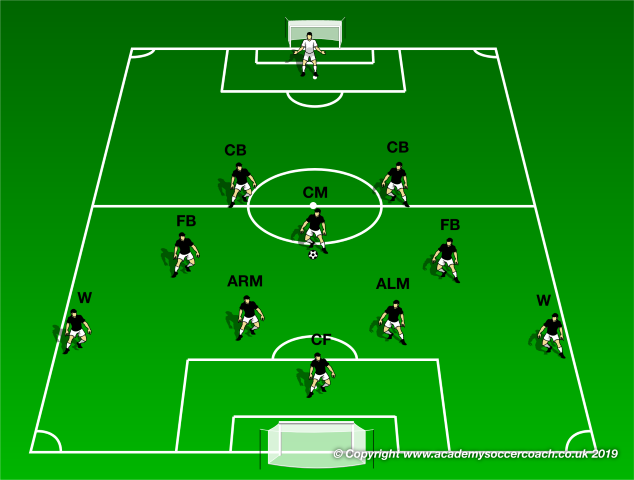
And these are the main transitions movements to cover the flanks and to avoid the opposition counter attacks, taking into consideration the recurrent inverted fullbacks tactics of Guardiola's Man City. CB, CM and W press the first receiver, the midfield sector, provide coverage of space and of passing lanes and the opposite FB and CB from the ball position provide balance at the back, to avoid deep passes and switches of side.
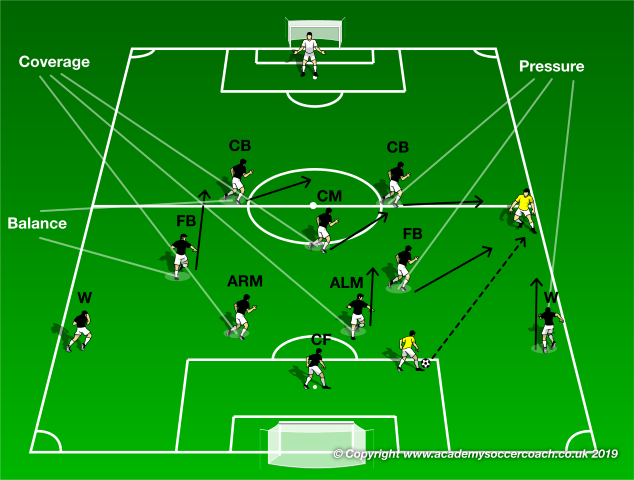
On the other side, this is Liverpool attacking shape inside the opposition half:
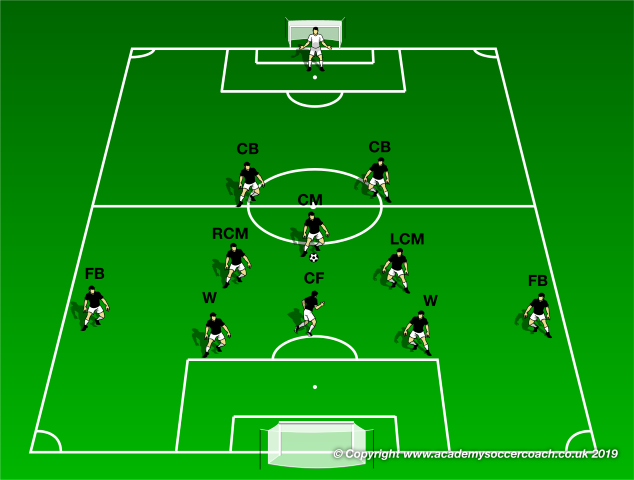
And these are the main transitions movements to cover the flanks and to avoid the opposition counter attacks, taking into consideration the advanced fullbacks and counter-pressing tactics of Klopp's Liverpool. The W and the CM who are placed inside the ball area press the first ball carrier and the CB and FB, while retreating, press the second potential receiver of the opposition. The CF and CM covers the space, the nearest passing lanes and potential switches of side. The opposite FB and CB provide balance, retreating back.
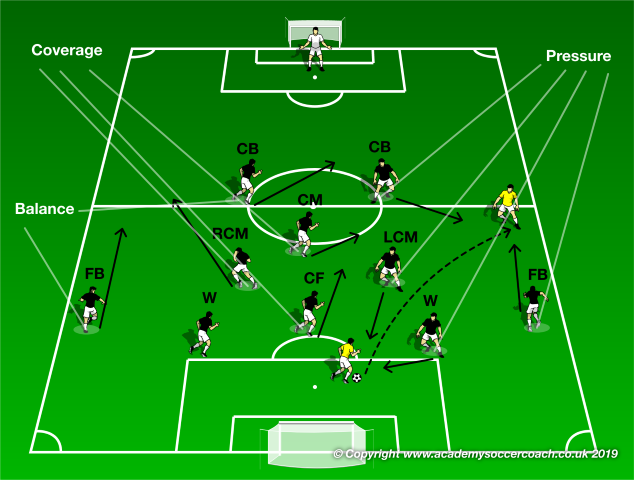
Basic principles of play without the ball
Pressure – When possession is lost the nearest player(s) try to regain the ball or to delay the opposition attack, applying pressure on the ball; the farther player(s) help this action by making recovery runs to deny the opponents the chance to play forward quickly.
Pressure phase can be divided into 3 different actions:
• Counter-pressing: it is the pressure around the ball during the transitions to defend phase of play, just after the loss of possession, to try to force the opposition toward a specific area, to win the ball back as soon as possible.
• Aggressive pressure: it is the pressure phase of the defending team, when the opposition has already made the possession safe, to force the direction of play backward or sideward, denying time and space and, if possible, to win the ball back directly or after a wrong choice of an opponent.
• Positional pressure: basically it is the closure of passing lanes to the opposition to force mistakes or direct the attacking phase toward a specific area of the field, where a defence numerical advantage can be exploited to put aggressive pressure. In this case, as the definition suggests, the positions of the players on the field is very important to ensure coverage and balance to not create gaps into the defence shape.
Again, Manchester City and Liverpool are significant examples of how to press the opponents. Liverpool positional pressure against Man City building up phase; Firmino, Salah and Manè are not pressing the opposition goalkeeper or center backs, but they are placed along the passing lanes toward the advanced midfielders and screening the center midfielder.
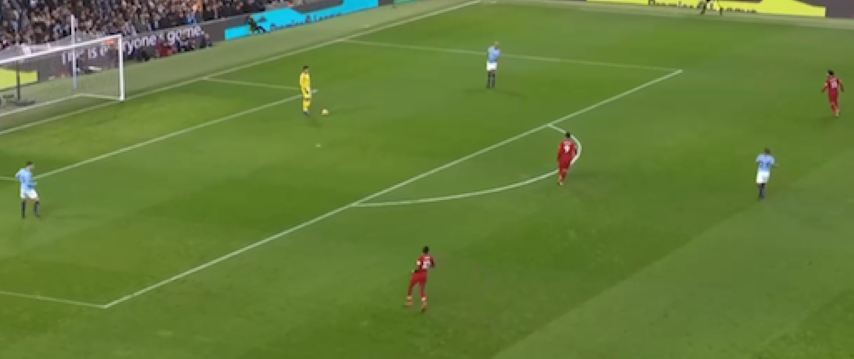
Man City positional pressure against Liverpool building up; this is another example of positional pressure, as all Liverpool potential receiver wouldn't have a safe option after the reception because Sterling, Aguero, Bernardo Silva and Sanè are screening all the forward passing solutions. Alisson is then forced to play a long pass to overcome the line of pressure.
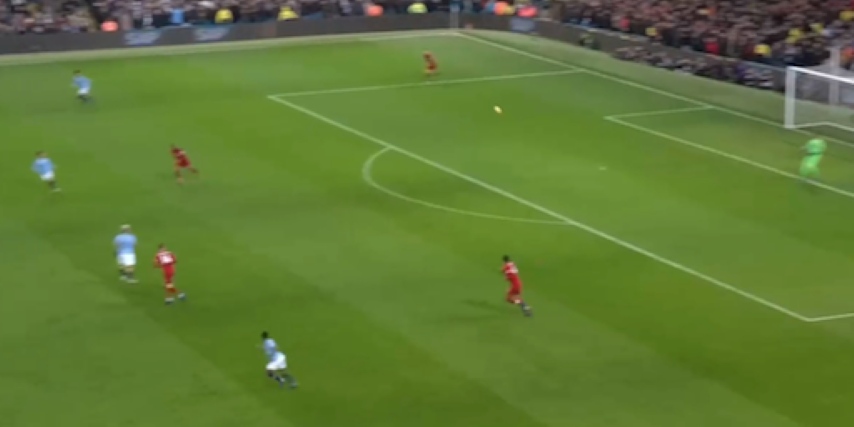
Manchester City aggressive pressure against Liverpool playing out phase; Lovren, the reds center backs in possession if forced outside due to a pressing opponent at his back, who prevent him from passing back to the goalkeeper. The first and easiest passing option, Arnold, is pressurized by Sanè and Wijnaldum and Henderson are not safe options...
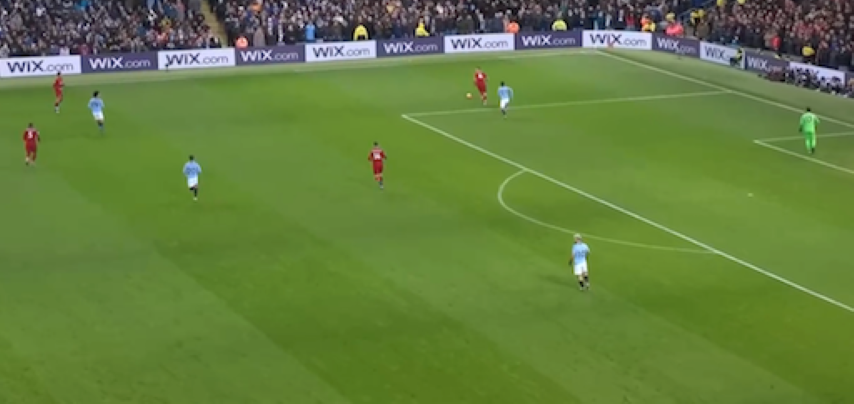
...Lovren tries to pass forward along the flank, where Wijnladum has run to; but Man City aim to exploit the equal 5 v 5 duel situation on the attacking left side of the final third.
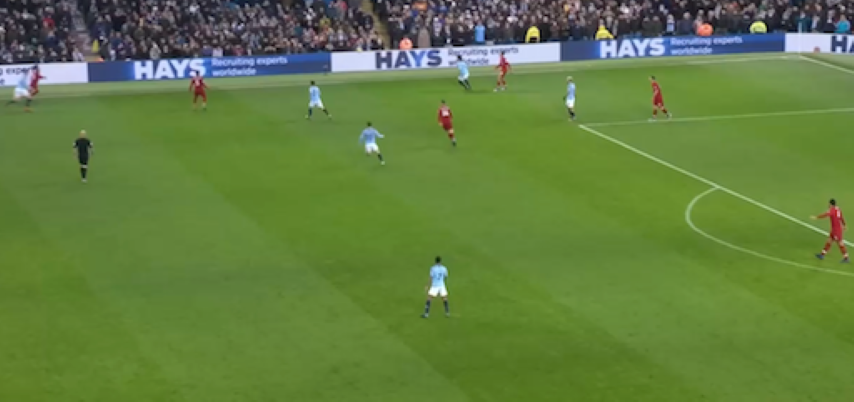
The different objectives of Liverpool and Man City pressure against the opposition build up phase starts to be very clear:
A. Liverpool aims to close forwards passing lanes, screening the potential receiver
B. Manchester City aims to create situations with equal number of players and to close down the opposition inside the ball area, preventing him from playing out or switching the side.
Liverpool positional pressure against Man City playing out phase; here again Kompany, Man City center back, has the possession, Firmino is screening the center midfielder, Salah and Manè are placed to defend the half-spaces to avoid any forward passing options (Salah is trying to force the direction of play toward the right side. Henderson is closing the center spaces in the middle third and Milner and Wijnaldum is man-marking the City advanced midfielders Bernardo Silva and David Silva. Even if a 6 v 6 situation can be noticed, to equalize the situation is not the main objective; the very first aim is to force the opposition possession phase and to prevent the move progression.

Man City aggressive pressure against Liverpool possession phase
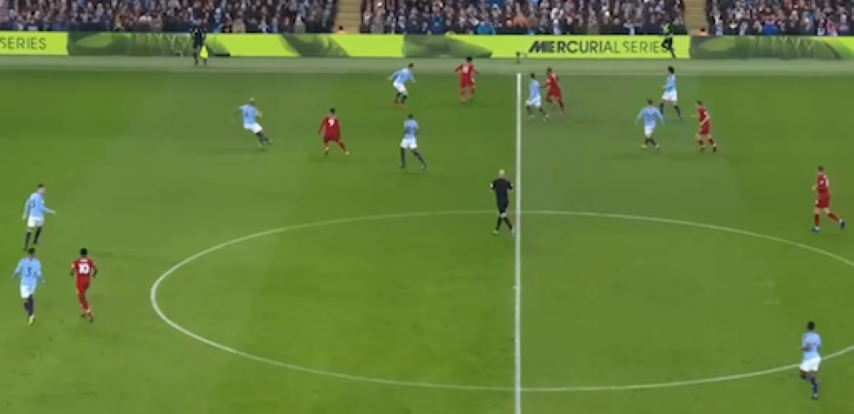
Liverpool aggressive pressure against Man City possession phase; only when the opponents are forced wide, the pressure phase becomes aggressive and only with the nearest player to the ball (Firmino); the other nearer players close the passing options to the ball carrier (Salah is ready to intercept a back pass to Kompany and Arnold is ready to win the ball while travelling to Sanè. Man City center midfielder may be free to receive, but he could be pressurized as well; Manè and Milner are ready to cover any switch of side, after providing balance in the center.
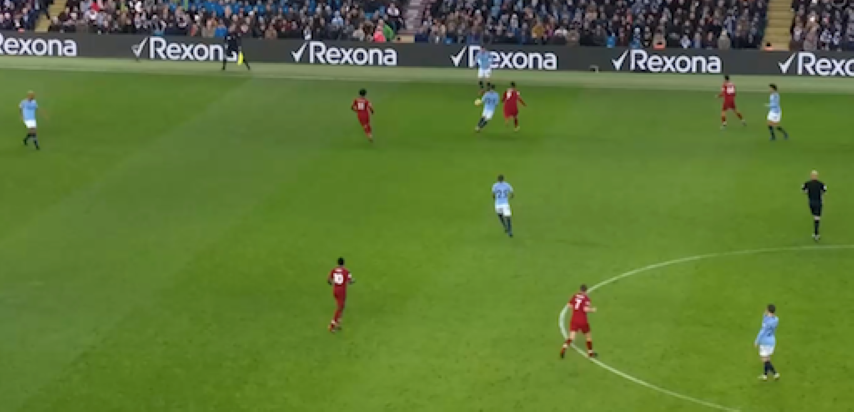
Delay – The defender(s) forces the attacking team to slow down the rhythm so that the defense phase can be organized; it's very important that to not being overcome easily, as the time for the team to organize the defense shape is shortened. The most famous example of 1-4-3-3 delaying tactic is the Barcelona 6" rule under Pep Guardiola reign.
The goal was to increase the speed in regaining the possession (within 6") through high intensity pressure after loosing the ball, preventing the opponents from counter attacking and winning the ball back with them out of positions. The nearest players ran forward and toward the first opponent in possession and the rest of the team moved closer together to organize and shape the defensive phase.
If it wasn't possible to win the ball back, the possession phase of the opponents was anyway delayed and the compact positioning prevented them from being dangerous just after the recovery of possession.
In this example Messi lost possession...
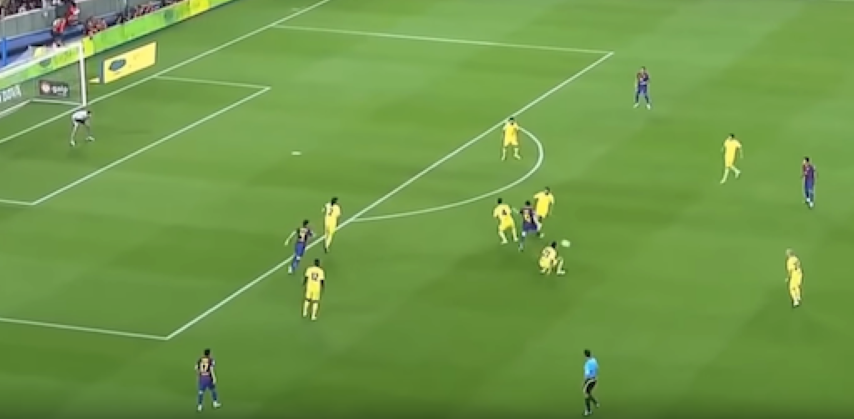
...But the narrow distances among Barcelona player allowed to counter-press the first opposition receiver, to prevent any progression of transition to attack phase.
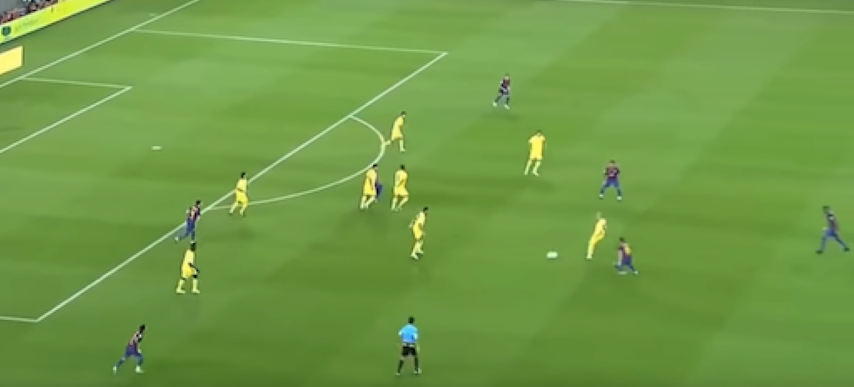
Again, the new attempt to play forward of the opponents, after a back pass, is defended pressing high; Barcelona had 8 players inside the attacking half, in this situation...
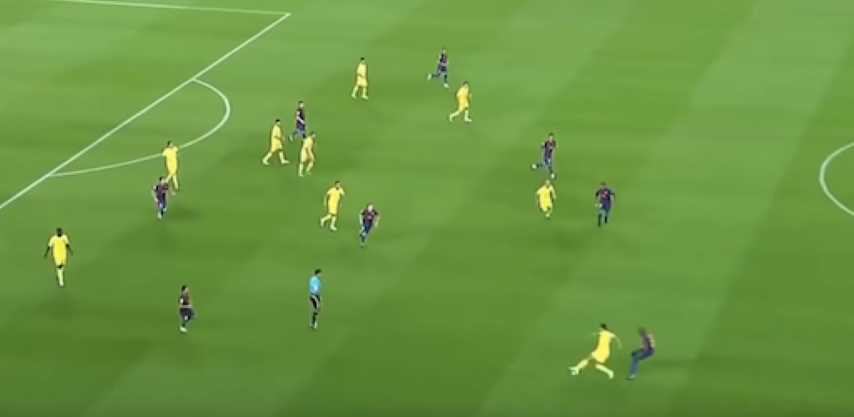
...Winning the ball back temporarily, with 7 players ready to attack from high positions...
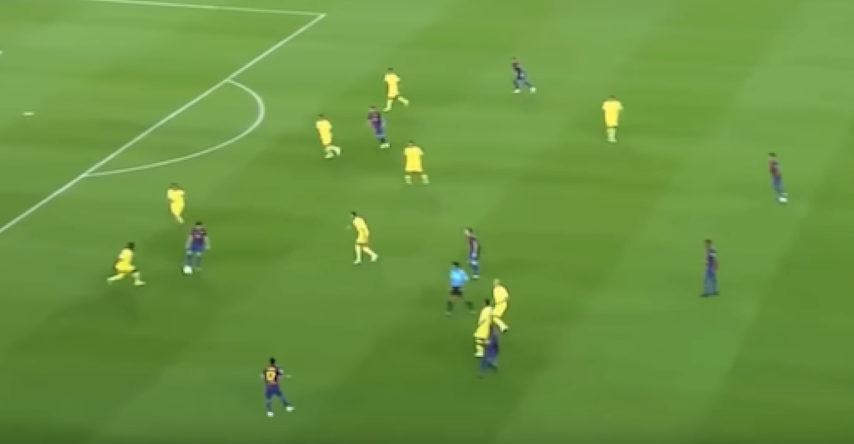
...And even if the opponents won the ball again, the goalkeeper was forced to play a long kick, because of the pressure of Barcelona players in the final third that prevented them from creating a proper attacking shape, as 8 field players had to manage the transition phases inside the first third.
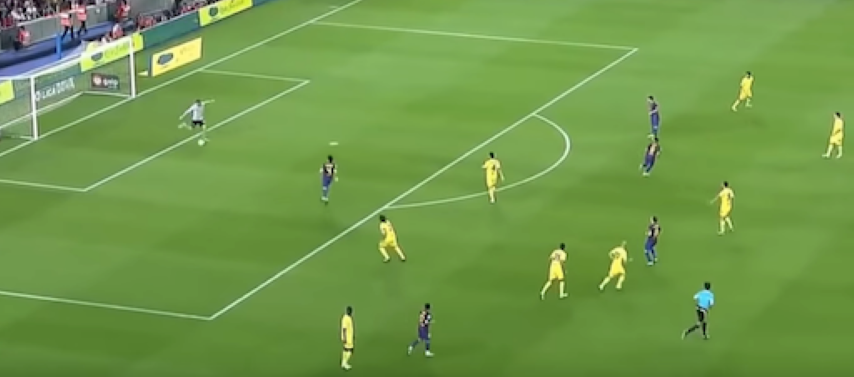
This way, the back line could cover the depth remaining placed high on the field, with numerical advantage at the back.
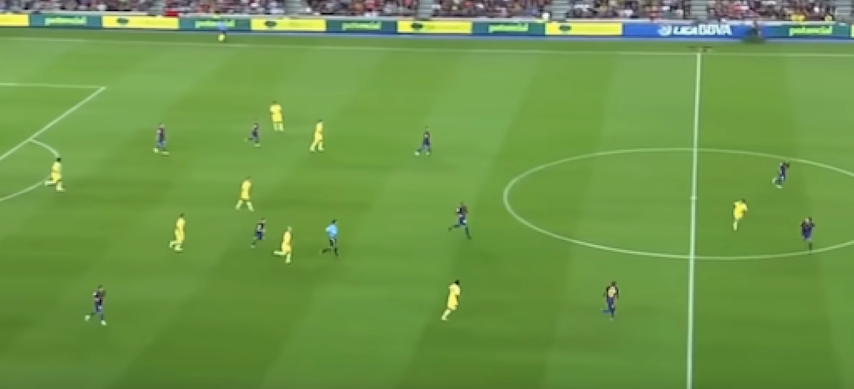
Depth –The immediate organization behind the pressuring defender(s), where all the other predetermined players should recover into defensive positions to support the teammates in case they are beaten. This is what is called "providing defensive cover".
Liverpool 2018/2019 is a great example of this principle: the front 3 (Manè, Firmino and Salah) are pressing the opposition building up phase in the final third together with a fourth teammate (Wjinaldum), who's coming from the middle third, but 3 players are covering the middle third behind the pressing lines (Fabinho, Robertson who pushed up and Henderson on the right).
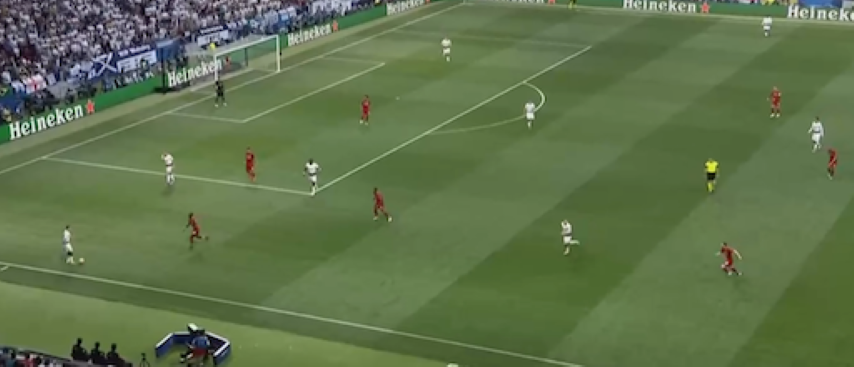
Even the pressure actions are overcome, the center backs are providing depth coverage at the back, accepting a 2 v 2 duel...
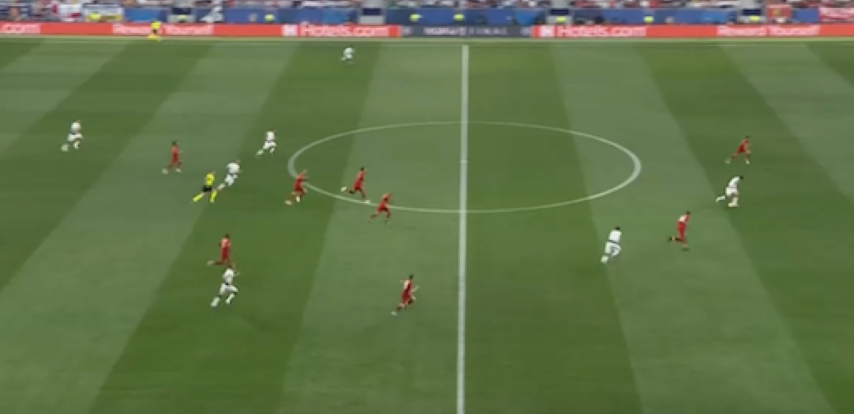
...delaying the opposition counter-attack and waiting for advanced lines retreating runs (Arnold diagonal run closes the goal space to the ball carrier and Matip is covering the nearest passing option toward the incoming teammate of the opponent with possession...
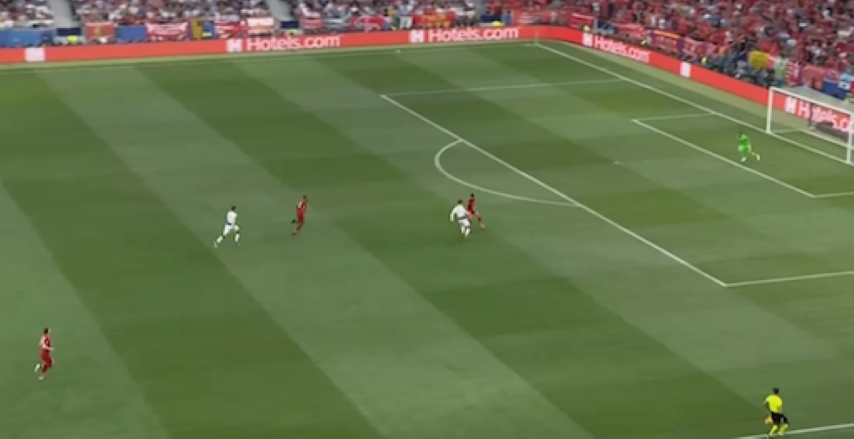
...And winning the ball back, exploiting the poor attacking shape of the opposition
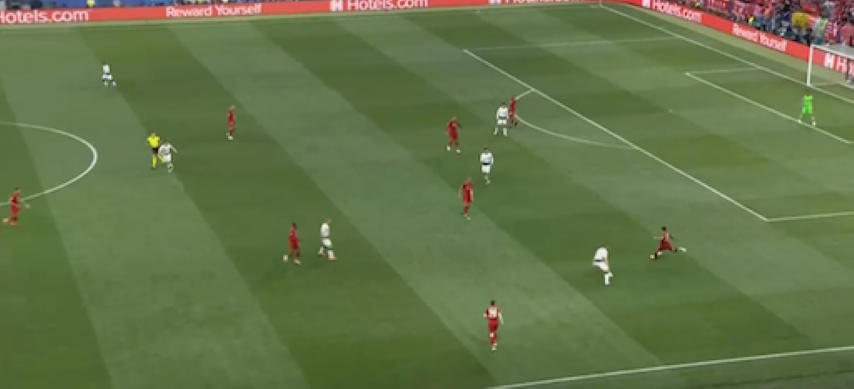
In this situation, where Liverpool is forced to defend the final third in the center, a line of 5 ensure the depth and box coverage behind the pressure line of 4 players; an opponent is placed between the lines, but the huge numerical advantage (5 v 1 +1) at the back would allow one player to push up and counter him, if he received a pass.
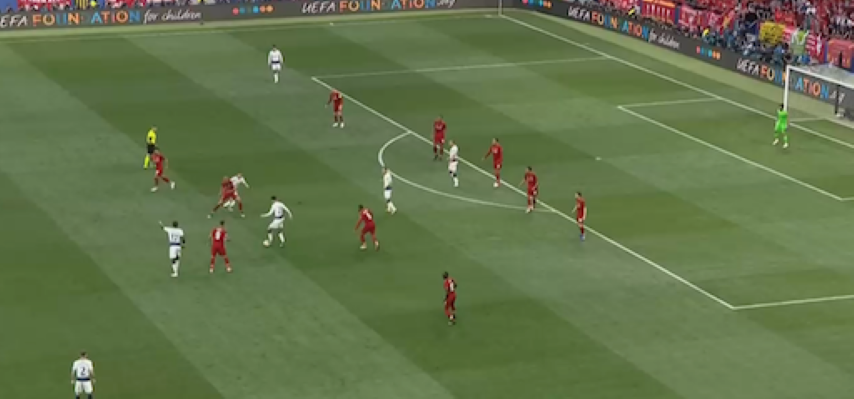
In this further example, there is a higher risk at the back, as Liverpool must face a 4 v 4 duel at the back, with 2 opponents between the lines.
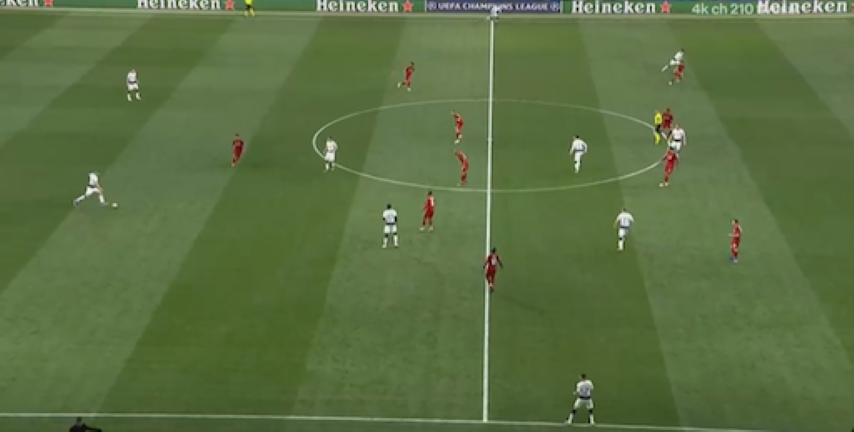
The timing of depth coverage and of double marking against the ball carrier become the keys to limit the danger in the first third; Van Dijk counters the ball carrier and Robertson doubles the mark against him to force the direction of play outside.
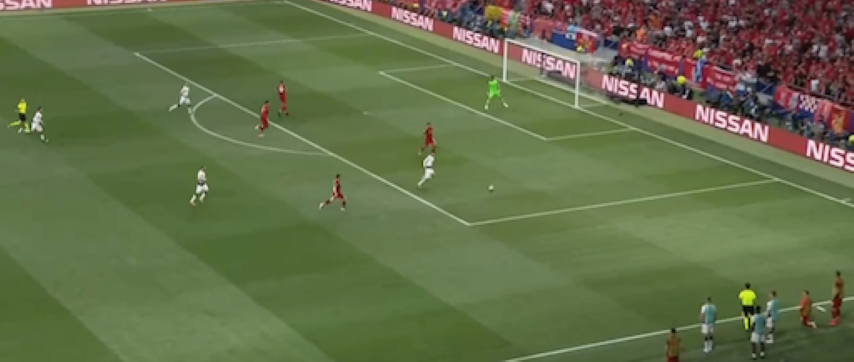
Balance – When the team overload the area of the ball, defenders away from the ball or in the opposite side of field must position themselves to cover the spaces (central areas or weak sides) to prevent penetrating runs into these spaces where the opponents may receive a pass. This is what it is meant with "provide balance to the defense". Liverpool and Manchester City are again 2 interesting examples of how to provide balance at the back.
Liverpool really overloads the ball area only when the opposition plays down the sideline, creating a strong side (4 v 3) on the ball, but always placing a man who could be able to pressurize the first potential receiver along the weak side (Robertson on the left in the picture).
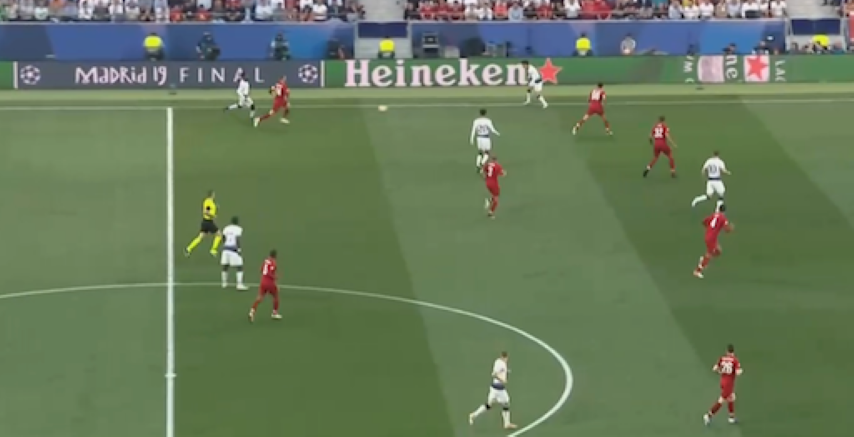
And if the opposition plays backward to switch the side, the defense shape remains organized and everyone look to protect the own field area.
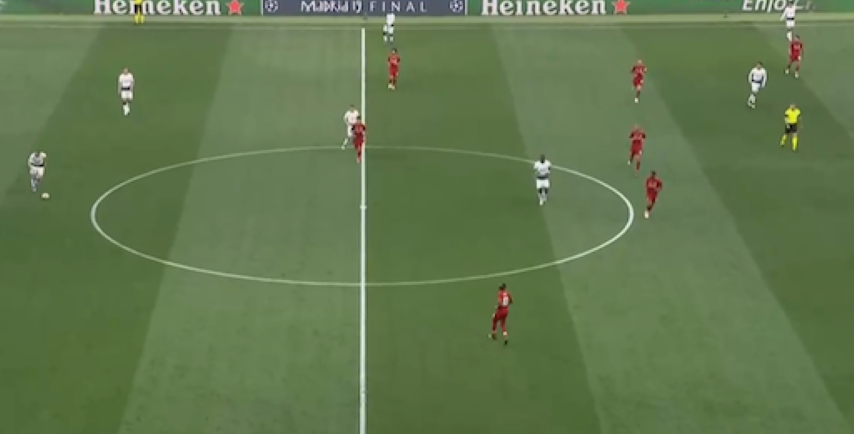
Liverpool 1-4-3-3 inside the defense half is very clear; all the center passing lanes are covered and the only possible safe options for opposition are wide passes.
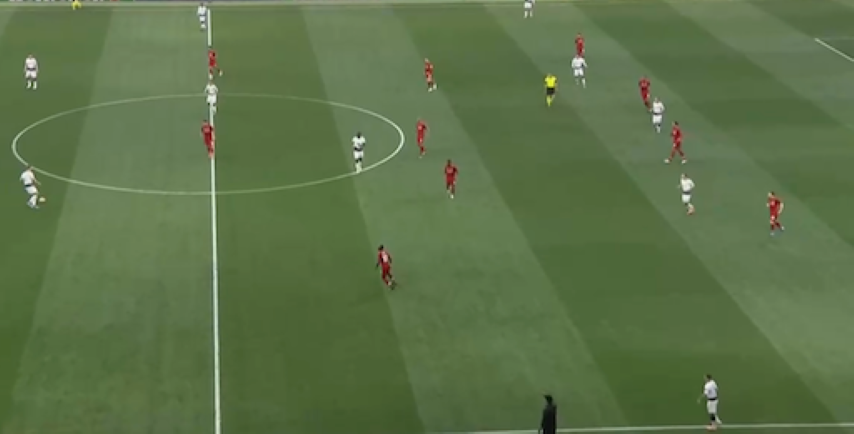
Compactness – While the defending team is retreating back toward the goal to organize the defense phase, time and space for the opponent must be limited, concentrating their defense all around the area of the ball. Defenders also recover centrally towards their goal in order to limit the opponents’ ability to directly attack the goal.
Compactness and balance are strictly related in Manchester City defensive phase, as the numerical advantage around the ball is always the first objective and the creation of a really strong side on the field is the consequence. If Liverpool consider balance as the coverage of the space, for Manchester City balance is to place players who are able to close any passing lanes out of the pressure area, creating a compact defense block.
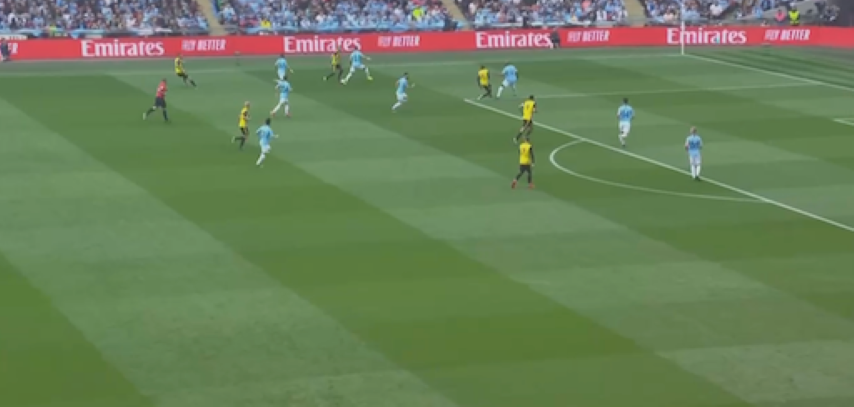
In these net 2 pictures, the opposition is able to play out from the pressure area.
In this first pictures compactness is ensured inside the box through a 3 v 1 duel against the opposition forward.
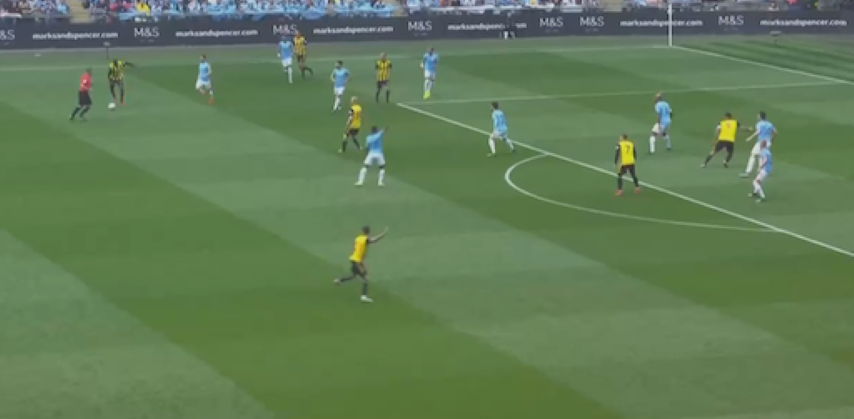
In this second one, the opposition is able to exploit the weak side of Man City defense shape and the whole team must retreat back toward the goal, losing yards on the field. The left fullback Zichenko covers the space toward the goal, forcing the opponents out wide...
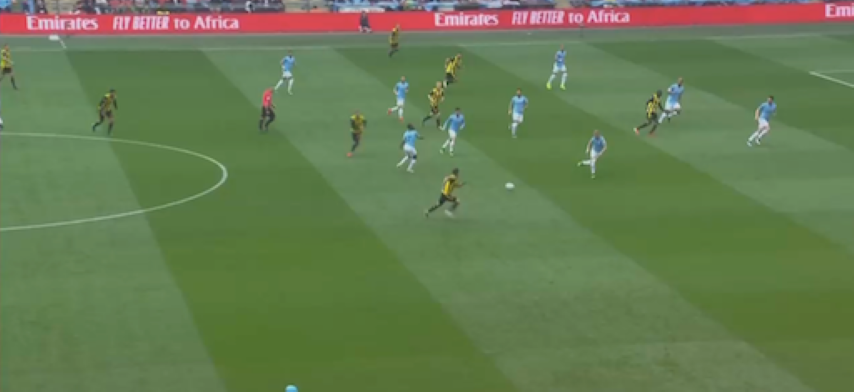
...And compactness is again obtained inside the box, as the opposition forwards are man-marked, 2 more player are able to rebound a cross pass and 2 more could be easily win defensive second times of the ball, just out of the penalty area.
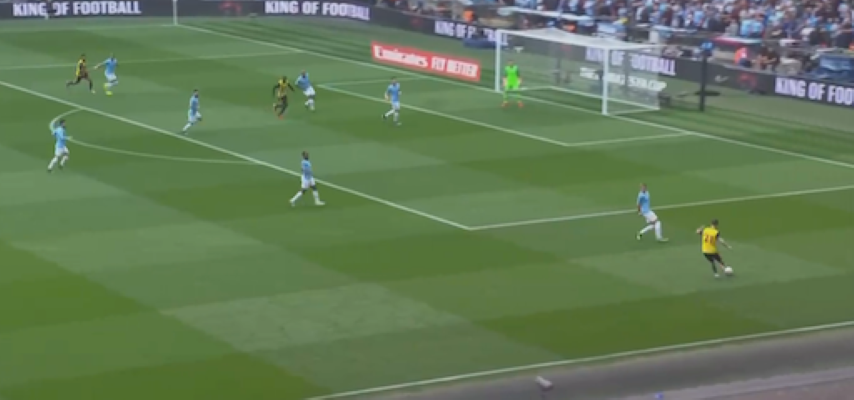
Liverpool shows a different interpretation of compactness; as we already analyzed, pressure phases are very strong only when the opponents are playing along the sidelines (all the opposition forward passing option are pressurized by Arnold and Fabinho and all the potential passing paths toward the center are covered by Firmino and Wijnaldum).
